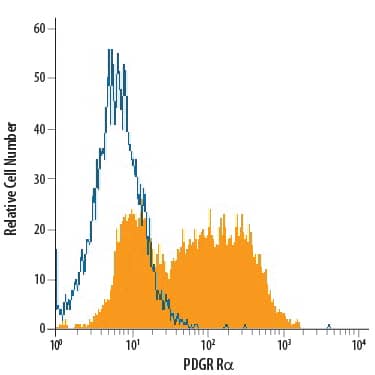Mouse PDGF R alpha APC-conjugated Antibody
R&D Systems, part of Bio-Techne | Catalog # FAB1062A

Key Product Details
Species Reactivity
Applications
Label
Antibody Source
Product Specifications
Immunogen
Leu25-Glu524 (Asp65Glu, Gly439Ala, Thr440Ala)
Accession # P26618
Specificity
Clonality
Host
Isotype
Scientific Data Images for Mouse PDGF R alpha APC-conjugated Antibody
Detection of PDGF R alpha in NIH‑3T3 Mouse Cell Line by Flow Cytometry.
NIH-3T3 mouse embryonic fibroblast cell line was stained with Goat Anti-Mouse PDGF Ra APC-conjugated Antigen Affinity-purified Polyclonal Antibody (Catalog # FAB1062A, filled histogram) or isotype control antibody (Catalog # IC108A, open histogram). View our protocol for Staining Membrane-associated Proteins.Detection of PDGF R alpha in 3T3-L1 cells by Flow Cytometry.
3T3-L1 cells were stained with Goat Anti-Mouse PDGF R alpha APC-conjugated Antigen Affinity-purified Polyclonal Antibody (Catalog # FAB1062A, filled histogram) or isotype control antibody (Catalog # IC108A, open histogram). View our protocol for Staining Membrane-associated Proteins.Applications for Mouse PDGF R alpha APC-conjugated Antibody
Flow Cytometry
Sample: NIH‑3T3 mouse embryonic fibroblast cell line, 3T3‑L1 mouse embryonic fibroblast adipose-like cell line
Formulation, Preparation, and Storage
Purification
Formulation
Shipping
Stability & Storage
- 12 months from date of receipt, 2 to 8 °C as supplied.
Background: PDGF R alpha
The platelet-derived growth factor (PDGF) family consists of proteins derived from four genes (PDGF-A, -B, -C, and -D) that form disulfide-linked homodimers (PDGF-AA, -BB, -CC, and -DD) and a heterodimer (PDGF-AB) (1, 2). These proteins regulate diverse cellular functions by binding to and inducing the homo- or hetero-dimerization of two receptors (PDGF R alpha and R beta). Whereas alpha/ alpha homo-dimerization is induced by PDGF-AA, -BB, -CC, and -AB, alpha/ beta hetero-dimerization is induced by PDGF-AB, -BB, -CC, and -DD, and beta/ beta homo-dimerization is induced only by PDGF-BB and -DD (1-4). Both PDGF R alpha and R beta are members of the class III subfamily of receptor tyrosine kinases (RTK) that also includes the receptors for M-CSF, SCF, and Flt-3 ligand. All class III RTKs are characterized by the presence of five immunoglobulin-like domains in their extracellular region and a split kinase domain in their intracellular region. Ligand-induced receptor dimerization results in autophosphorylation in trans resulting in the activation of several intracellular signaling pathways that can lead to cell proliferation, cell survival, cytoskeletal rearrangement, and cell migration. Many cell types, including fibroblasts and smooth muscle cells, express both the alpha and beta receptors. Others have only the alpha receptors (oligodendrocyte progenitor cells, mesothelial cells, liver sinusoidal endothelial cells, astrocytes, platelets, and megakaryocytes) or only the beta receptors (myoblasts, capillary endothelial cells, pericytes, T cells, myeloid hematopoietic cells, and macrophages) (1, 2). Recombinant mouse and human soluble PDGF R beta bind PDGF with high affinity and are potent PDGF antagonists.
References
- Betsholtz, C. et al. (2001) BioEssays 23:494.
- Ostman, A. and A.H. Heldin (2001) Advances in Cancer Research 80:1.
- Gilbertson, D. et al. (2001) J. Biol. Chem. 276:27406.
- LaRochells, W.J. et al. (2001) Nature Cell Biol. 3:517.
Long Name
Alternate Names
Gene Symbol
UniProt
Additional PDGF R alpha Products
Product Documents for Mouse PDGF R alpha APC-conjugated Antibody
Product Specific Notices for Mouse PDGF R alpha APC-conjugated Antibody
For research use only

